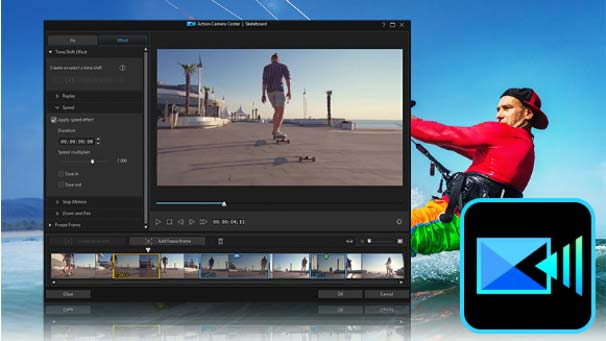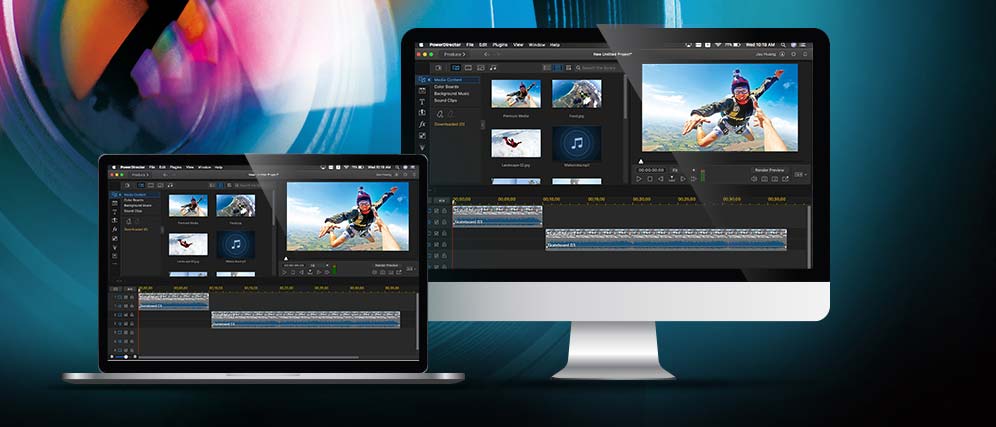Tom's Guide Verdict
CyberLink PowerDirector is a solid video editor for folks who are looking to quickly create short personal projects from their footage.
Pros
- +
Square 1:1 aspect ratio, great for social media
- +
Built in motion graphics titles and royalty free music
- +
Intuitive interface for beginners
- +
Audio scrubbing and 4K video previews
Cons
- -
No image stabilization effect
- -
Keyboard shortcuts aren’t intuitive for longtime Mac users
Why you can trust Tom's Guide
We’ve consistently rated CyberLink PowerDirector as one of the best video editing software for Windows users for its user-friendly interface and regularly updated features; PowerDirector 18, for instance, received a glowing 4-star review from us. Now, for the first time, the program is available for macOS users.
PowerDirector offers a lot more flexibility and control than a program like iMovie, but isn’t quite as advanced as Adobe Premiere Elements 2021 or Final Cut Pro. Although experienced editors might find it lacking on this macOS version, for an initial launch there are a number of features that will appeal to enthusiasts looking for something a bit more powerful than iMovie.
CyberLink PowerDirector 365: Price and availability
PowerDirector 365 for macOS was released in the fall of 2020. It uses a subscription based model and can be purchased for $19.99 for a single month, or $69.99 for an entire year—making it a more affordable option than Adobe’s Premiere Elements ($99.99) or Final Cut ($299.99).
CyberLink PowerDirector 365: System requirements
PowerDirector 365 requires a computer with at least Mac OSX 10.14 operating system and an Intel Core™ i-series or Apple M1 (with Rosetta support) CPU.
CyberLink PowerDirector 365: MacOS vs. Windows versions
PowerDirector 365 has borrowed many of the features found in the Ultimate version of the Windows program—audio scrubbing, 4K video preview, library preview and 1:1 aspect ratio are all there. But common tools like image stabilization are notably absent from this first version of the software. According to Cyberlink, this feature and others will be added through updates coming in 2021.
CyberLink PowerDirector 365: Interface
PowerDirector is designed to be a plug-and-play video editing software; even if you’ve never edited a video before, the interface is approachable and easy to pick up. A timeline sits on the bottom of the screen and has sections for music and video files. When you drag your files into the timeline, the program automatically splits clips into the sections in which they belong.

By default, PowerDirector 365 stacks the tracks so video sits at the top and effects and overlays appear underneath the main track. If you’ve used any other video editing software this setup won’t seem intuitive, but PowerDirector allows users who prefer a different layout to reverse the stacking order of the tracks. This can be changed through the program’s Preferences menu.
When you select a clip within the timeline, options for Tools, Fix/Enhance and Keyframe appear. Tools is where you can select blending modes, crop, zoom and pan, adjust video speed, access Masks and the PiP designer. Fix/Enhance menu allows you to make exposure, color, lens distortion, and white balance adjustments, while Keyframe allows you to make micro adjustments to the footage. Essentially any edit that you might want to make to the footage exists in plain sight, rather than being buried in a menu. Users can undock the timeline and library to create a custom workspace as well.

If you’re a longtime Mac user, navigating PowerDirector’s workspace will take some getting used to. The keyboard shortcuts and trackpad movements that might be burned into your muscle memory don’t necessarily apply here. Many of the editing tools that you will want to access are found by right-clicking. It’s a slower way of working, and not quite as precise as other programs.
CyberLink PowerDirector 365: Key features and what’s new
Since this is the first time PowerDirector has been available for macOS, everything here is technically new. Although the program isn’t quite as robust as the Windows version of PowerDirector—you won’t find an image stabilization effect in this initial release—Cyberlink has integrated most of the features found in the Windows version.

Audio scrubbing and 4K video previews—two features only found in the PowerDirector Ultra version for Windows— are available in the macOS version.

The PIP (picture-in-picture) designer lets you combine clips together for use in different projects. It’s similar to the Double Exposure feature found in Adobe Premiere Elements in that it allows you to play video within graphic elements. Within the PIP you will find tools to easily Chroma Key footage for interesting layering techniques, add masks, add keyframes and animate objects within a frame. Clips edited within the PIP designer can be saved and reused with other projects as well—an interesting feature for editing social teasers or sizzle reels.

Keyframes offer more control over how and when effects are applied to footage and gives editors the ability to make adjustments to object position, transparency and scale.
The program comes loaded with a number of motion-graphic titles, lower-thirds and credits—additional downloadable templates will be added every month. Drag and drop one of the presets into your timeline and then customize animations, typeface and color by double clicking on it. You can see a preview of the animated text in the Title Designer, making it easy to experiment before saving the title into your timeline.

Video Collage Designer creates a multicam view using anywhere from two to seven pieces of footage. Like many of PowerDirector’s other features it's really a matter of dragging and dropping and then applying customizations. Everything can be previewed within the Video Collage Designer before it's added into the timeline. Additional Video Collage layouts can be downloaded through Cyberlink.
The program comes with hundreds of royalty-free background music options that can be added to your videos and, like so many of PowerDirector’s other features, new tracks are added every few months. Songs are sorted by genre and so finding something that fits the mood of your video piece is fairly straightforward.
Downloadable Color LUTs make it easy to adjust the colors of a scene by dragging and dropping into the timeline. The LUT’s work a lot like an Instagram filter, but also let users make micro adjustments using the Fix/Enhance menu. The Effect Room is also where you can find effects that will Glitch, Mirror, or Fisheye your footage. These can be fun, but use them sparingly. Unfortunately this version of PowerDirector lacks some of the most commonly used effects by video editors like auto-stabilization or rolling-shutter reduction.
CyberLink PowerDirector 365: Verdict
Cyberlink’s PowerDirector 365 for macOS is an excellent option for novice and amateur editors looking for something a bit more advanced than iMovie. The subscription model is more affordable than Adobe’s programs and offers users extended access to effects, motion graphic titles, royalty-free background music and Color LUTs—giving the program added value.
The lack of macOS friendly shortcuts and some of the program’s language will likely be frustrating for folks who have spent a lot of time working with Mac products. And maneuvering through the timeline to make precision edits—like cutting to the beat of a song—can be a little tricky.
Still, PowerDirector’s UI is very intuitive for new users. We see this program as being perfect for families looking to edit together end-of-year recaps for the holidays or footage documenting milestones—think of all the unwatched videos from such events sitting in your camera roll. Its ability to handle 4K footage is a huge asset, as is the ability to edit and export in a 1:1 format — perfect for Instagram. That feature alone will make this an appealing tool for content creators who want a way to edit footage on a laptop instead of their phone.

Jeanette D. Moses is a New York based filmmaker and photographer known for capturing the intimacy of New York City's creative communities. She has been freelancing for Tom's Guide since 2020. She loves shooting music, tinkering with new technology, all things analog, and learning about archaic photographic processes. She’s been photographing the music scene in New York City since 2012 and began writing about photography shortly after. In addition to Tom’s Guide, her stories have been published on Pop Photo, DP Review, Digital Photo Pro and The Phoblographer. In 2021 she was selected as one of Dr. Martens Filmmakers of the Year to direct a film about New York City's DIY music scene.

